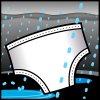gismo
Touchdown! Greaser!
It may still be working but simply not up to dealing with the serious icing you encountered. From the pictures I'd say you had an up front and personal lesson on SLD, and fortunately you get to put this experience to good use since you managed to live through it.My interpretation was due to lack of knowledge of some tools that were available.
Airmets and sigmets did not provide an accurate picture of the act actual conditions.
Realizing that we were picking up ice and the pitot failing were almost simultaneous. Believe me when I say it all happened very quickly. The pitot heat worked on preflight. I have learned a lot from this experience. Hopefully someone else can learn from my mistakes.
FWIW, it sounds to me like you managed the situation fairly well with the possible exception of not hightailing it out of the clouds and ice as soon as possible once it was obvious that ice was present. You are going to experience unexpected adverse weather again if you keep flying in IMC and it's important to have an exit strategy (e.g. plan B) whenever that's a possibility.
Scott D has been providing you with some useful tools and I think you'd find his workshop program fairly useful.


